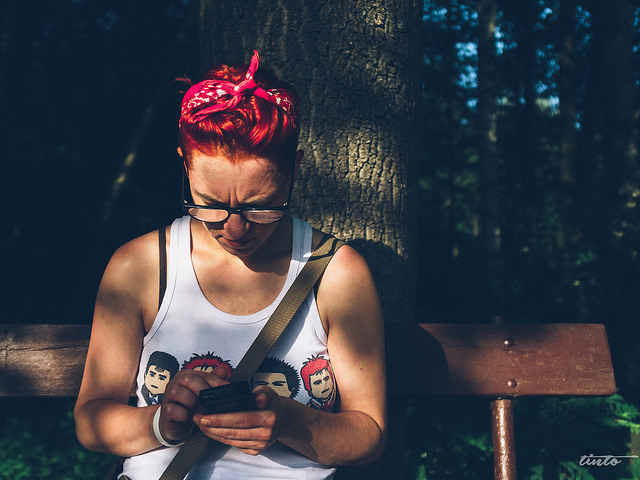
I was driving home on a busy freeway a few nights ago—my vision was poor, all the other cars were in a rush and a big sign flashed above us, alerting us to the detour we were obligatorily set to embark upon.
Down an old windy road riddled in potholes, eagerly peering through the windscreen for any glimpse of further directions, my fellow drivers and I were eventually guided back onto the main freeway by a sudden series of bright, flashing arrows emblazoned on signs.
It got a little hairy toward the end of the detour, and I took comfort when I noticed a road-worker clad in the trademark fluorescent yellow garb by the side of the road. Obviously he was there to assist and direct any confused motorists?
Unfortunately for us, he was completely and utterly consumed by his smartphone.
I felt a slight sense of fear (or was it panic?) when I realised that the only person solely responsible for ensuring the safety of the highway motorists that night was too absorbed in his phone to notice the drivers cautiously passing him by.
Luckily, we all made it through unscathed and back in familiar highway territory. But what if…?
Half an hour later, I pulled up at a set of lights and notice the man in the car next to me with his phone, hands-free in the literal sense, wedged between his shoulder and ear with his head cocked over to one side to keep it in place while he drove off.
Almost simultaneously I happened to glance over to a bus stop, where every soul has their head buried in their device, seemingly oblivious to the half-a-dozen other people standing within millimetres of their personal space.
It occurred to me that never before have we lived in a time where we are more familiar with the top of people’s heads than their faces or eyes.
Getting your roots done is now arguably more important than putting your makeup on.
It will come as no surprise that these people are not alone in their “smartphone zombie” (or smombie) behaviour. In fact, a recent U.K. survey estimated that smartphone users are now checking their devices more than 221 times per day. Two hundred and twenty-one times! That seems quite preposterous on the one hand, but totally believable on the other. Terminator Genisys may not seem so far-fetched after all.
All jokes aside, the truth is that people now seem unwittingly prepared to die for wi-fi.
Sixty-one “petextrians” died last year in the New South Wales state of Australia alone. Augsburg in Bavaria has installed traffic lights in the ground at pedestrian crossings and designated “texting lanes” have been introduced in China, Antwerp, Belgium and Thailand to tackle the growing number of incidents caused by the head-down tribe.
Should governments be encouraging this behaviour by installing “smombie-specific” infrastructure at road junctions? Are they simply offering a band-aid solution to a much more significant and inherent social epidemic?
Perhaps they would benefit from perusing some of the alarming statistics that have recently emerged regarding smartphone and tablet usage of our younger generations. A recent report highlights that the average age of a child getting their first smartphone is 10.3 years. Perhaps even more concerning is that almost 40 percent of kids today will have a social media account by the age of 11.4 years, with almost 30 percent having private access in their bedrooms without any strict parental supervision. As parents and guardians, are we seriously okay with this?
If these figures aren’t alarming enough, the impact on the well-being of the younger, tech-savvy generation is far from impressive. Recent reports reveal that psychologists are struggling to keep up with an increasing social media addiction resulting in anxiety, “brain burnout,” FOMO (Fear of Missing Out) and NoMo (No Mobile).
And researchers in the new field of “interruption science” have discovered that it takes an average of 25 minutes to recover from a phone call. In the modern day world these types of “interruptions” come every 11 minutes, and according to Pico Iyer (author of The Art of Stillness: Adventures in Going Nowhere), this means that we are never quite caught up with our lives.
The Anxiety and Depression Association of America reports that around 15 million adults suffer from social anxiety. So not only are we living in a smartphone-complacent society manifested by smombies and petextrians, but we now know that our smartphone addictions are also contributing to our mental health and making us generally unhappy and possibly even miserable.
According to one psychologist, one of the main issues is that people are not getting enough time in the day to simply do nothing. Or, as Jeff Garcia puts it, time to just think, to daydream, or to connect with the environment and the people in it.
If Steve Jobs would trade all of his technology to spend an afternoon with Socrates, surely we can afford to reserve a little space each day to exist without the demands of our own tech devices? (And why would the creator of our smartphone devices desire the opportunity to trade all he has created just to sit with a Greek philosopher? You might find the answer once you take some time out from your device!)
Whether it be a smartphone, tablet, laptop or desktop, don’t we owe it to ourselves to stop and just be? To think for ourselves?
“But how..?” you might ask. I certainly had no idea how to control my smartphone infliction until I consciously created space in my life to exist without the constant demands and naggings of my iPhone. The following are just a few little ideas I have started to implement that have helped to increase my “phone-free time” without necessarily removing me entirely from the online world:
>> Leaving my phone in the kitchen before going to bed. This was tough at the start, because I realised I relied so much on my phone in a multifaceted sense (such as a torch to light the way to the bathroom or kids’ room during the night, an alarm to wake me up of a morning or a crutch to default to if I needed to “connect” with people before bed or when I first woke up). But this one decision has been truly liberating and helped me to regain a sense of control over a device that was controlling my every move.
>> Walking the dog without my phone. This is a really simple exercise (and can be implemented minus the dog!). Try it and see how free you feel—even if just for half an hour!
>> Read a book. Not on Kindle. A real, tangible, paper-feel book. One that you can earmark or scribble notes in. Whatever takes your fancy. Try it. It is almost ethereal when you read an entire chapter without being able to click to another page via a hyperlink!
>> Visit your local gardens or natural open space. Or even take a stroll in your own backyard garden patch, and take the time to listen to the birds, or smell the flowers, or perch yourself on a tree branch.
>> Attend a yoga class.
>> Listen to music the old fashioned way. Commit to one album, or CD (or record if you are lucky enough to own one!), and enjoy each and every tune in succession.
>> Meditate, meditate, meditate!
Or, in the words of John Lennon, “…Turn off your mind, relax, and float downstream.”
Author: Tehla Bower
Image: Jörg Schubert/Flickr
Editors: Emily Bartran; Yoli Ramazzina











Read 0 comments and reply